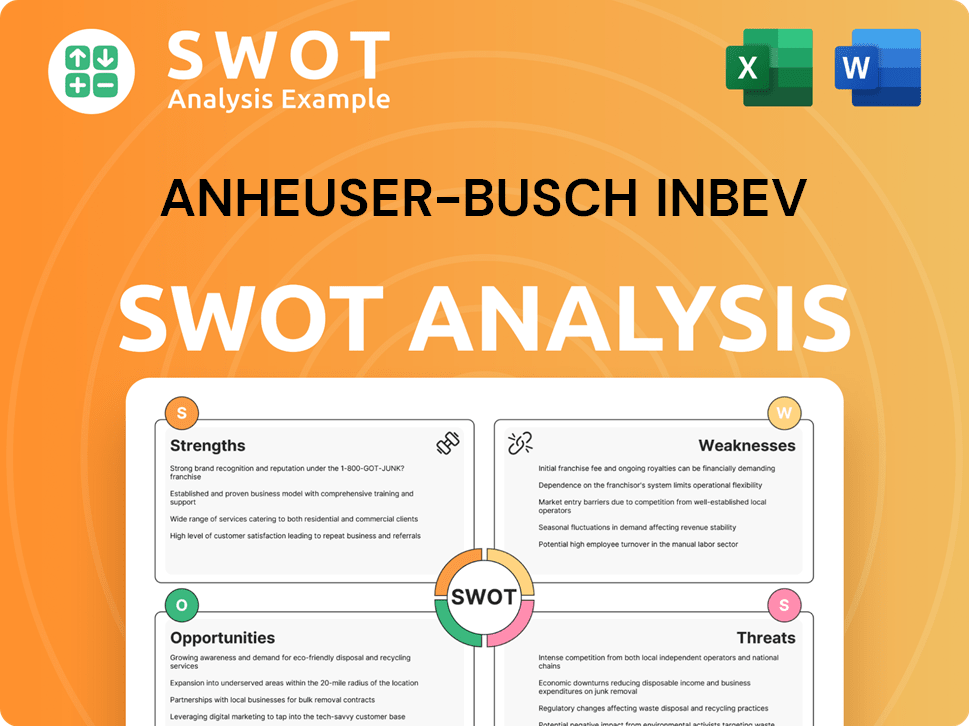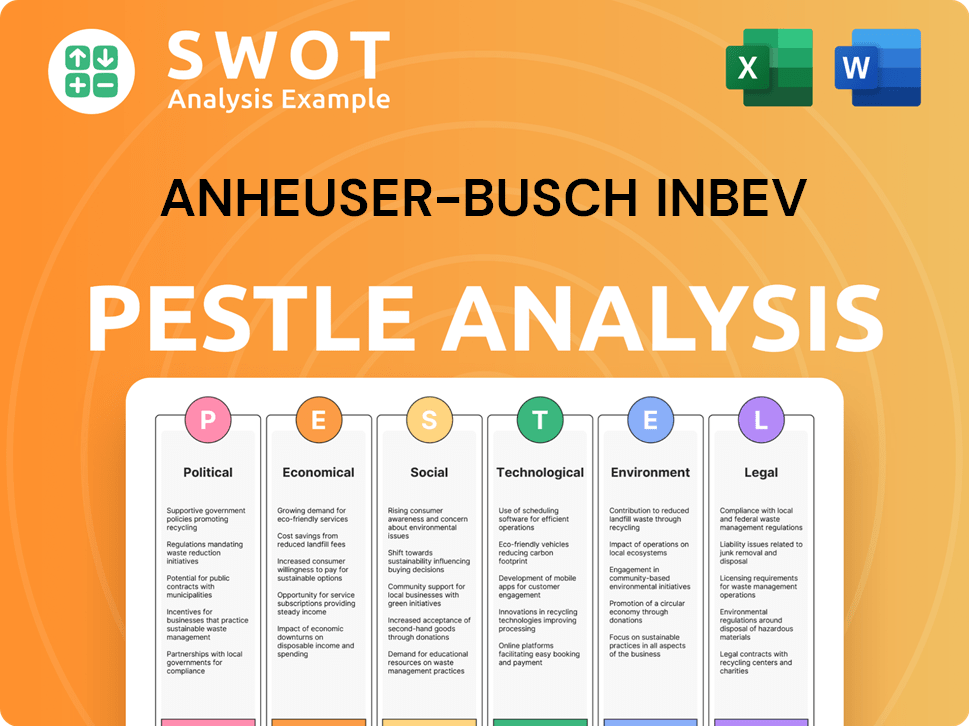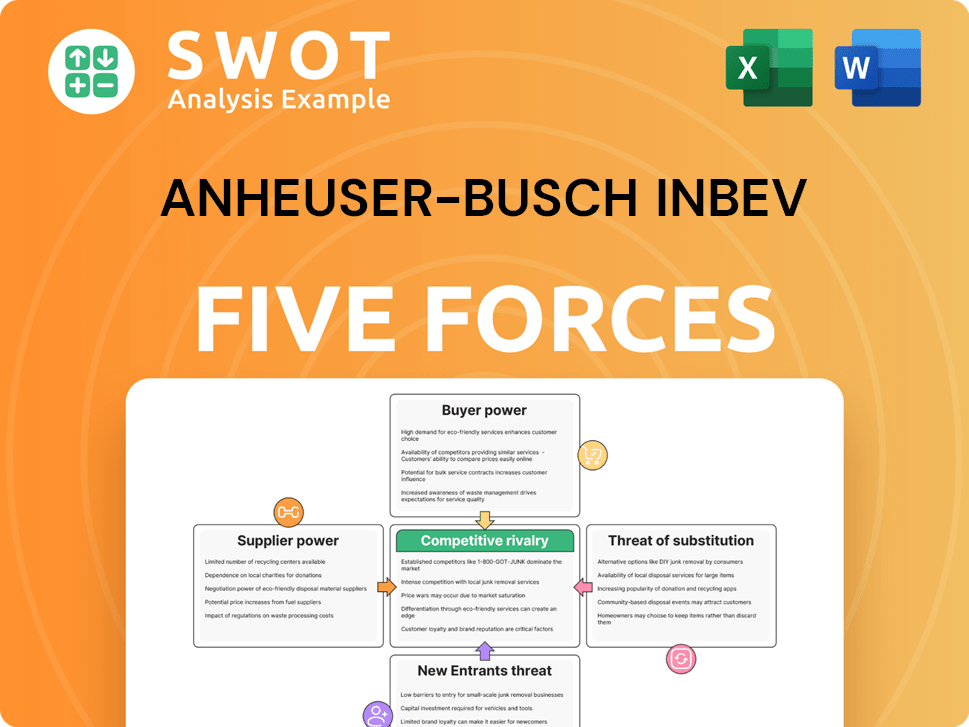Anheuser-Busch InBev Bundle
How Does Anheuser-Busch InBev Dominate the Global Beer Market?
Anheuser-Busch InBev (AB InBev) isn't just brewing beer; it's crafting a global sales and marketing empire. In a rapidly evolving industry, AB InBev invested a staggering $7.2 billion in sales and marketing in 2024, signaling its commitment to growth. This article dives deep into the Anheuser-Busch InBev SWOT Analysis, exploring the strategies that have propelled this brewing giant to the top.

From its 600-year brewing heritage to its $59.8 billion revenue in 2024, AB InBev's story is one of constant adaptation. This article explores AB InBev's sophisticated omnichannel approach, including its AB InBev marketing plan, which leverages digital platforms to connect with consumers directly. We'll examine how AB InBev sales marketing strategies, including its brand positioning, fuel its success in the competitive global beer market.
How Does Anheuser-Busch InBev Reach Its Customers?
The sales channels of Anheuser-Busch InBev (AB InBev) encompass a multifaceted approach to reach its global customer base. This strategy includes a blend of traditional and modern methods to ensure its diverse portfolio of products is accessible to consumers worldwide. The company continually adapts its sales channels to meet evolving market demands and consumer preferences, leveraging both established networks and innovative digital platforms.
AB InBev's sales strategy is built on a foundation of wholesale distributors and physical retail locations, which have historically been crucial to its go-to-market strategy. However, the company has significantly increased its focus on digital transformation. This shift involves expanding e-commerce and direct-to-consumer (DTC) solutions, reflecting a strategic move to enhance its sales reach and operational efficiency.
The company's sales strategy is designed to ensure its products are available to a wide audience. This involves a combination of established distribution networks and cutting-edge digital platforms, all working in concert to drive sales and maintain a strong market presence. This approach enables AB InBev to adapt to changing consumer behaviors and market dynamics effectively.
AB InBev relies on a robust network of wholesale distributors and physical retail locations. These traditional channels remain essential for reaching a broad consumer base. This established infrastructure ensures wide product availability and supports the company's extensive market reach.
The BEES platform is a key component of AB InBev's digital transformation. As of December 31, 2024, BEES operated in 28 markets, contributing 75% of AB InBev's total revenue. In Q1 2025, the platform processed 10 million orders, a 27% year-over-year increase, with a GMV of $11.6 billion.
AB InBev's DTC ecosystem includes platforms such as Zé Delivery, TaDa Delivery, and PerfectDraft. These platforms generated $1.4 billion in revenue in 2024, a 9% increase from the previous year. In Q1 2025, these platforms processed 19.2 million e-commerce orders. These platforms enable direct consumer engagement and data-driven decision-making.
AB InBev leverages key partnerships and exclusive distribution deals to enhance its reach and market share. This approach involves adapting product offerings and marketing campaigns to local tastes and preferences. These strategic alliances help AB InBev maintain a competitive edge in the global beer market.
The digital sales channels, particularly BEES and DTC platforms, are experiencing significant growth, reflecting a broader shift in the Owners & Shareholders of Anheuser-Busch InBev sales strategy. BEES captured $49 billion in gross merchandise value (GMV) in 2024, a 19% increase from 2023. In the first quarter of 2025, the BEES marketplace reached $645 million in GMV from sales of third-party products, a 53% increase.
- BEES processed over 36 million orders in 2024, a 31% increase from the previous year.
- DTC platforms processed over 76 million orders in 2024.
- Digital platforms enable AB InBev to detect early consumer shifts and react to changes.
- These platforms contribute to operational efficiency and enable direct engagement with consumers.
Anheuser-Busch InBev SWOT Analysis
- Complete SWOT Breakdown
- Fully Customizable
- Editable in Excel & Word
- Professional Formatting
- Investor-Ready Format

What Marketing Tactics Does Anheuser-Busch InBev Use?
The marketing tactics employed by Anheuser-Busch InBev (AB InBev) are multifaceted, leveraging both digital innovation and traditional media to enhance brand awareness, generate leads, and boost sales across its extensive brand portfolio. In 2024, AB InBev allocated a substantial $7.2 billion globally to sales and marketing, emphasizing its key brands, platforms, and brand-building capabilities. This significant investment underscores its commitment to leading the long-term growth of the global beer category.
AB InBev's approach integrates data-driven insights to tailor product offerings and marketing campaigns to local preferences, ensuring consistent brand messaging while accommodating regional variations. The company's customer segmentation and personalization strategies are designed to deliver targeted advertising and optimize product development, reaching the most relevant audiences effectively.
AB InBev's marketing strategy is designed to maintain and expand its market share in the global beer market. The company focuses on creating a strong brand presence and engaging with consumers through various channels, including digital platforms and traditional media. This comprehensive approach helps AB InBev to stay competitive and drive sales in the dynamic beer industry.
AB InBev utilizes digital marketing extensively to enhance brand awareness and drive customer engagement. These initiatives include social media campaigns, email marketing, and search engine optimization (SEO) to increase sales through online channels.
The expansion of the BEES platform is a key component of AB InBev's digital strategy. BEES facilitates extensive data collection, with over 70% of revenue stemming from this platform, enabling early detection of consumer shifts and responsive strategy adjustments.
AB InBev's direct-to-consumer (DTC) solutions, such as Zé Delivery, TaDa Delivery, and PerfectDraft, demonstrate a significant shift towards data-driven marketing and direct consumer engagement. These platforms help to build stronger customer relationships.
Traditional media remains a crucial part of AB InBev's marketing mix. The company actively uses TV, radio, print, and events to reach a broad audience. Strategic investments in advertising, such as Super Bowl ads, have proven successful.
AB InBev tailors its product offerings and marketing campaigns to local tastes and preferences. This approach ensures consistent brand messaging while allowing for regional adaptation, making the brand more relevant to consumers.
The company actively engages in partnerships and sponsorships to build brand loyalty and expand its market reach. These collaborations help to increase brand visibility and connect with consumers in meaningful ways.
AB InBev's marketing strategy is a blend of digital innovation and traditional methods, which help to create brand awareness and drive sales. The company's investment in sales and marketing, along with its focus on digital platforms and traditional media, demonstrates its commitment to maintaining its position in the global beer market. To understand the company’s history, you can read more in the Brief History of Anheuser-Busch InBev.
AB InBev's marketing tactics are multifaceted, integrating digital and traditional strategies to enhance brand visibility and drive sales. The company's focus on digital platforms, customer engagement, and data-driven insights helps to maintain a competitive edge. Here are the key components:
- Digital Marketing: Utilizing AI, big data, e-commerce, social media, and IoT to improve operational efficiency and drive sales.
- B2B and DTC Platforms: Leveraging platforms like BEES, Zé Delivery, TaDa Delivery, and PerfectDraft for data collection and direct consumer engagement.
- Traditional Media: Employing TV, radio, print, and events to reach a broad audience.
- Localization: Tailoring product offerings and marketing campaigns to local tastes and preferences.
- Partnerships and Sponsorships: Building brand loyalty and expanding market reach through collaborations.
- Data-Driven Insights: Using data to drive customer segmentation, personalization, and targeted advertising.
Anheuser-Busch InBev PESTLE Analysis
- Covers All 6 PESTLE Categories
- No Research Needed – Save Hours of Work
- Built by Experts, Trusted by Consultants
- Instant Download, Ready to Use
- 100% Editable, Fully Customizable

How Is Anheuser-Busch InBev Positioned in the Market?
AB InBev's brand positioning is a cornerstone of its Anheuser-Busch InBev strategy, emphasizing global leadership and a diverse portfolio. This strategy allows the company to target a wide range of consumers. The company's approach is built on premiumization, innovation, and sustainability, setting it apart in the beer industry marketing.
The company's brand message focuses on quality, enjoyable experiences, and innovation. AB InBev adapts its visual identity and tone of voice to resonate with local cultures while maintaining a consistent global brand message. For example, Corona is promoted as a premium, refreshing beer, while Budweiser highlights its heritage. The company's focus on premiumization has been a key growth driver, with Corona seeing double-digit volume growth in over 30 markets.
AB InBev also focuses on sustainability and corporate responsibility to appeal to environmentally conscious consumers. This commitment enhances its brand image and aligns with evolving consumer values. The company's responsiveness to consumer sentiment and competitive threats is demonstrated through continuous innovation and strategic adaptation. AB InBev continues to invest in the low-to-no-alcohol beer and 'Beyond Beer' categories, which are outperforming the mainstream beer category, with its non-alcoholic beer portfolio growing by more than 20% in 2024.
AB InBev is positioned as a global leader in the global beer market, with a presence in numerous countries. This leadership is supported by its extensive distribution network and iconic brands. The company leverages its scale to achieve efficiencies and maintain a competitive edge.
AB InBev's diverse portfolio of over 500 beer brands allows it to cater to a wide range of consumer preferences. This includes global brands like Budweiser, Corona, and Stella Artois. This diversity helps in capturing different market segments.
The company emphasizes premiumization, with its premium and super-premium portfolio contributing approximately two-thirds of its revenue in 2024. Budweiser distribution expanded to 235 cities. This strategy focuses on higher-margin products.
AB InBev invests in innovation and sustainability to appeal to modern consumers. The company's focus on eco-friendly practices and reducing its environmental footprint enhances its brand image. This approach aligns with consumer values.
AB InBev targets a broad audience, from beer enthusiasts to those seeking premium experiences. The company uses its diverse brand portfolio to cater to various demographics. The company carefully considers its AB InBev target audience when developing its AB InBev marketing plan.
Brand consistency is maintained across all channels and touchpoints. This consistency helps build brand recognition and trust. AB InBev ensures that its brand message is clear and consistent globally.
AB InBev's competitive advantage comes from its global scale, brand portfolio, and premiumization strategy. The company's focus on innovation and sustainability further strengthens its position. This is an important factor in AB InBev's competitive advantage.
The company leverages digital marketing to reach its target audience. This includes social media, online advertising, and content marketing. The company uses an effective AB InBev digital marketing strategy.
AB InBev employs various AB InBev sales techniques to drive sales, including promotional offers and partnerships. The company also focuses on effective AB InBev distribution strategy. The company is always looking for new ways to improve its sales.
AB InBev holds a significant AB InBev market share in the global beer market. Its strong brand portfolio and effective strategies contribute to its market dominance. The company continues to innovate to maintain its market share.
Anheuser-Busch InBev Business Model Canvas
- Complete 9-Block Business Model Canvas
- Effortlessly Communicate Your Business Strategy
- Investor-Ready BMC Format
- 100% Editable and Customizable
- Clear and Structured Layout

What Are Anheuser-Busch InBev’s Most Notable Campaigns?
The sales and marketing strategies of Anheuser-Busch InBev (AB InBev) are consistently bolstered by impactful campaigns designed to strengthen its brands and drive growth. In 2024, the company invested a significant $7.2 billion globally in sales and marketing. This investment is primarily focused on fortifying its megabrands, a key component of its strategic approach to maintain a competitive edge in the global beer market.
AB InBev's marketing plan includes leveraging major events like the Super Bowl to maximize brand visibility. The company's strategic investments in these campaigns are designed to accelerate brand power and drive continued commercial momentum. These efforts aim to build strong consumer connections and foster efficient, profitable growth, with megabrands increasing net revenue.
AB InBev's strategies also extend to digital transformation, focusing on channel and geographic expansion. Despite facing challenges, the company emphasizes its agility and commitment to supporting its partners. For a deeper understanding of AB InBev's operations, you can explore the Revenue Streams & Business Model of Anheuser-Busch InBev.
AB InBev's Super Bowl campaigns have consistently proven successful, leading to accelerated share gains. In early 2025, the company's large Super Bowl ad spend was a success. Commercials, such as Budweiser's 'First Delivery', frequently rank high in viewer favorites, contributing to AB InBev's brand presence.
This global campaign, featuring artist Anderson .Paak, was brought to India in April 2025. The campaign reinforces Budweiser's commitment to youth culture through music and experiences. AB InBev India adapted the messaging to resonate with the local audience's preferences for music and festivals.
AB InBev includes extensive Chinese New Year activations as part of its marketing strategy. These campaigns are a part of the company's continuous investment in its megabrands. These activations help in channel and geographic expansion.
A new integrated campaign for Harbin Zero Sugar was launched in partnership with the NBA. This campaign highlights the company's focus on channel and geographic expansion. The campaign is a part of the company's digital transformation efforts.
AB InBev's sales techniques include a focus on megabrands, channel expansion, and digital transformation. The company emphasizes agility and support for its partners. These strategies are critical for maintaining its AB InBev competitive advantage in the global beer market.
- Strategic investments in advertising campaigns.
- Focus on building brand power.
- Adaptation to local market preferences, e.g., in India.
- Leveraging major events like the Super Bowl.
Anheuser-Busch InBev Porter's Five Forces Analysis
- Covers All 5 Competitive Forces in Detail
- Structured for Consultants, Students, and Founders
- 100% Editable in Microsoft Word & Excel
- Instant Digital Download – Use Immediately
- Compatible with Mac & PC – Fully Unlocked

Related Blogs
- What are Mission Vision & Core Values of Anheuser-Busch InBev Company?
- What is Competitive Landscape of Anheuser-Busch InBev Company?
- What is Growth Strategy and Future Prospects of Anheuser-Busch InBev Company?
- How Does Anheuser-Busch InBev Company Work?
- What is Brief History of Anheuser-Busch InBev Company?
- Who Owns Anheuser-Busch InBev Company?
- What is Customer Demographics and Target Market of Anheuser-Busch InBev Company?
Disclaimer
All information, articles, and product details provided on this website are for general informational and educational purposes only. We do not claim any ownership over, nor do we intend to infringe upon, any trademarks, copyrights, logos, brand names, or other intellectual property mentioned or depicted on this site. Such intellectual property remains the property of its respective owners, and any references here are made solely for identification or informational purposes, without implying any affiliation, endorsement, or partnership.
We make no representations or warranties, express or implied, regarding the accuracy, completeness, or suitability of any content or products presented. Nothing on this website should be construed as legal, tax, investment, financial, medical, or other professional advice. In addition, no part of this site—including articles or product references—constitutes a solicitation, recommendation, endorsement, advertisement, or offer to buy or sell any securities, franchises, or other financial instruments, particularly in jurisdictions where such activity would be unlawful.
All content is of a general nature and may not address the specific circumstances of any individual or entity. It is not a substitute for professional advice or services. Any actions you take based on the information provided here are strictly at your own risk. You accept full responsibility for any decisions or outcomes arising from your use of this website and agree to release us from any liability in connection with your use of, or reliance upon, the content or products found herein.